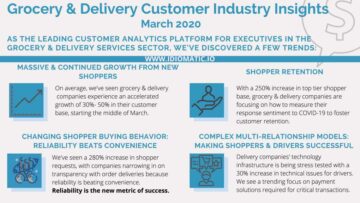About 90 days ago I was on a monthly zoom call with colleagues (California had sheltered-in-place already). On this call, we took a straw poll to see how many people thought we’d be able to meet in person in one month’s time. Only two of us voted no.
The world has changed immensely in 90 days and we are all still getting used to it. All of us have to adjust. At Idiomatic, we’ve noticed these changes are massively affecting the CX efforts of our clients as their customers’ behavior changes.
That is why we convenied our first ever Webinar last week, entitled CX during COVID to try to share some of our clients most interesting observations and learnings. You can listen to the entire hour-long conversation with Medium, Upwork, and Flickr or you can jump to some of the highlight answers by clicking on the links below.
- What has been the biggest change in customer behavior? (5:40)
- How do you go about communicating pain points to other orgs like PMs and Marketing? (18:20)
- How do you tie support metrics to business metrics like revenue and churn, and how has that changed? (30:00)
- For two-sided marketplaces, has your team needed to focus on one side more than the other, or has it stayed equal? (36:30)
- Are your teams hourly or salary, and how has employee sentiment changed? (41:45)
At Idiomatic, we tend to think of the customer response to COVID in terms of first, second, and third order effects. On the first order are the obvious changes (shelter-in-place, closed office space, etc.), the second order effects are downstream of the first (less shopping at the store means more online food orders, more time at home, less travel, etc.), and the third order effects are downstream of the first and second (more time on social media, more online education purchases, etc.). For each business, you must ask yourself, even if you haven’t faced consequences yet, will you be subject to second and third-order effects from Covid.
The first order effect of recent changes has been devastating for certain businesses. We have been monitoring our clients in the events and sports sectors and some have been completely crushed. These types of obvious changes have been written about ad naseum. In the webinar and in this post, we wanted to discuss some second and third order effects.
2nd Order Effects: Online Grocery & Food.
Idiomatic serves multiple online food and grocery delivery businesses that have seen large booms in transaction volume due to COVID-19 and new shoppers moving online. It’s easy to miss the subtler changes happening when you are suddenly swamped with 2-4x the volume just trying to stay afloat. See below for some of the summary of insights we pulled out from March.

One highlight is the shift in customer expectations from needing everything fast to needing accuracy and reliability. Put another way, customers no longer care if deliveries are late, as long as they get there eventually and have what the customer ordered. The consequences to your CX strategy could be large. Should you change the way you incentivize agents to put less emphasis on delays and more emphasis on accuracy? How can you track the new issues that pop up as your systems are being stress tested on an almost daily basis?
3rd Order Effects: Online Content & Education.
Idiomatic serves several online content companies including online education. While it took longer than March, several of these companies have seen a more recent downstream bump in transactions due to customers being at home and having more time to be online. Because most of these customers are first-time purchasers, we have see massive increases with first-time user issues, including login, account setup, and purchasing. Our clients who have already done the work of segmenting customer issues based on account status (existing vs. first-time) are in a much better position to take advantage of this new volume by retaining it on an ongoing basis. Others are having to scramble to address these first-time purchaser issues that have long gone on as accepted pain points in the customer journey.
Key Questions to Ask Going Forward:
- Are the same things important to your customers? (Consider the delivery example of speed vs. accuracy tradeoff).
- How has the nature of feedback changed?
- Are new pain points surfacing or all of a sudden dominating our customer feedback channels?
- How well can we map the customer journey based on feedback?
If you aren’t harnessing the changes in your feedback to make changes in your business, your CX will suffer because the world is changing and leaving you behind.




